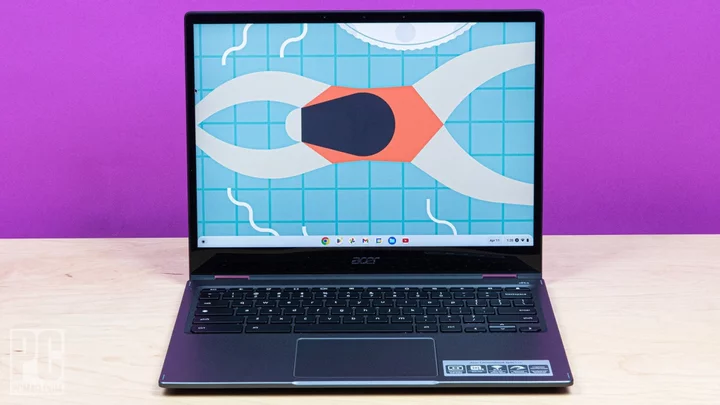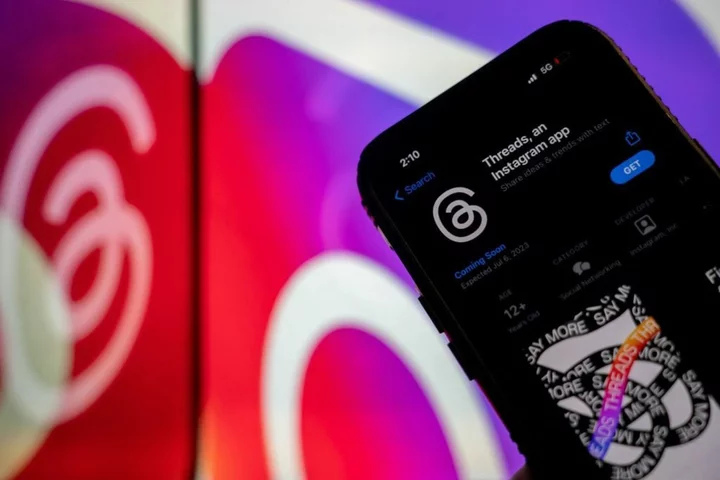Acer has won more than its share of PCMag Editors' Choice awards for Chromebooks, with the Acer Chromebook Spin 714 succeeding older Spin 713 models as our premium pick. The new Acer Chromebook Spin 513 ($599.99) is a 2-in-1 convertible positioned below those systems. However, it still has an upscale feel about it, thanks to a tall 3:2 aspect ratio display like its Spin 700 Series predecessors. It's not as desirable as the 714, but the Acer Chromebook Spin 513 is $130 less, making it a relatively affordable and versatile grab-and-go productivity partner.
ARM and Hammer
Naturally, Acer's 500 Series Chromebooks make compromises its costlier 700 Series models don't. In the case of the Spin 513 (model CP513-2H-K62Y), the main differences are a MediaTek Kompanio ARM processor instead of an Intel Core or AMD Ryzen chip and an eMMC flash drive instead of a faster solid-state drive. This version also lacks a bundled stylus or pen for its touch screen.
Years of testing have taught us that Chromebooks with ARM processors, while adequate, aren't as quick as their x86 rivals. Of course, this Acer's Kompanio 1380 claims to be the peppiest yet. The 6-nanometer chip combines four 3.0GHz Cortex A78 cores—the Qualcomm Snapdragon 7c in models like the Lenovo IdeaPad Duet 5 Chromebook uses older Cortex A77 architecture—with four Cortex A55 efficient cores plus five-core Mali-G57 integrated graphics.
The Spin 513 teams the new CPU with 8GB of memory and 128GB of eMMC storage. The Corning Gorilla Glass touch screen is a 13.5-inch IPS panel with a 2,256-by-1,504-pixel resolution. While its 3:2 aspect ratio isn't ideal for viewing videos, it is excellent for working with word processors or browsing webpages by minimizing scrolling.
Equipped with an aluminum lid and bottom in a dark hue Acer calls Titanium Gray, the Spin 514 measures 0.64 by 11.8 by 9.3 inches and weighs 2.8 pounds. The 16:10 aspect ratio of the Spin 714 gives it a slightly different footprint—0.71 by 12.3 by 8.8 inches—and ups its weight to 3.1 pounds. The almost-square chassis is slim and attractive but I found a tad more flex than I like when grasping the screen corners or pressing the keyboard deck. True to its price, you will find no fingerprint reader here, and the webcam lacks a privacy shutter.
The Spin 513 lands on our Chromebook "B" list rather than the "A" list because it has no HDMI port. If you want to plug in an external monitor, you'll need a DisplayPort adapter for one of the two USB 3.2 Type-C ports (one on each side, either accommodating the AC adapter). You'll also find a single USB 3.2 Type-A port on its left, along with an audio jack and a microSD card slot. You'll find a power button and volume rocker on the right edge. Wi-Fi 6E and Bluetooth 5.2 handle wireless connections.
Minimal Conferencing
The webcam is a cheap item with old-school 720p instead of 1080p resolution. Its images are fairly well-lit and colorful but noisy and grainy, unable to focus on my patterned shirt. You'll find a DTS Audio logo above the keyboard, but the bottom-mounted speakers produce a relatively weak, hollow sound—it's not all that loud, with no bass to speak of. Overlapping tracks become swallowed up and you'll hear an overall roughness, like an AM radio with a blanket thrown over it.
Acer's backlit keyboard follows the standard Chromebook layout with a menu/search key in place of Caps Lock and browser and system controls along the top row. The cursor arrow keys are small but arranged in the proper inverted T. The keyboard has a snappy and tappy typing feel; it's a little loud but easy to maintain a fast pace.
A chrome-trimmed, buttonless touchpad glides smoothly, though its clicks are stiff if you prefer a click to a simple tap. The touch screen kept up with my fastest swipes and scribbles with decent palm rejection.
Too many affordable Chromebooks have dim, dull displays. The Spin 513 screen is enjoyably bright—Acer says it's 360 nits—and colorful, with rich and well-saturated hues. The panel's viewing angles are wide, though the touch glass shows reflections at extreme angles, and its contrast is decent. Photos and videos looked fantastic, and the screen's whites look clean rather than dingy, helped by the ability to tilt the screen far back (or rotate it all the way around to tablet mode).
Like all Chromebooks, the Acer works in a handful of "looks like" or scaled resolutions—the default is 1,410 by 910—since the native 2,256 by 1,504 pixels makes the taskbar shelf and icons too small to see comfortably. The largest, 1,085 by 723, enlarges screen elements to Fisher-Price size.
Testing the Acer Chromebook Spin 513: A Five-Way ChromeOS Clash
For our performance charts, we pitted the Acer Chromebook Spin 513 against another ARM Kompanio-based Acer from a year ago, the Acer Chromebook 514. In lieu of a convertible, we added a 13.3-inch detachable OLED laptop, the abovementioned Lenovo IdeaPad Duet 5 Chromebook.
The 16-inch, Intel Core i3-powered Lenovo 5i Chromebook was enough of a big-screen bargain to claim an Editors' Choice award recently. The last entry, and the only system here priced above the Spin 713 at $999, is the premium HP Dragonfly Pro Chromebook.
We test Chromebooks with three overall performance benchmark suites—one ChromeOS, one Android, and one online. The first, CrXPRT 2 by Principled Technologies, measures how quickly a system performs everyday tasks in six workloads such as applying photo effects, graphing a stock portfolio, analyzing DNA sequences, and generating 3D shapes using WebGL.
The second, UL's PCMark for Android Work 3.0, performs assorted productivity operations in a smartphone-style window. Finally, Basemark Web 3.0 runs in a browser tab to combine low-level JavaScript calculations with CSS and WebGL content. All three yield numeric scores; higher numbers are better.
Landing in the middle of the pack, the Spin 513, bested the other two ARM Chromebooks but was well behind the Core i3 Lenovo 5i and the Core i5 HP Dragonfly Pro. It did squeak out a win in PCMark for Android, however, indicating it's an ideal choice for Google Play Store entertainment and games.
We also run an Android CPU benchmark, the multi-core Geekbench from Primate Labs. An Android GPU test, GFXBench 5.0, stress-tests both low-level routines like texturing and high-level, game-like image rendering that exercises graphics and compute shaders, reporting results in frames per second (fps).
Finally, to test a Chromebook's battery, we loop a 720p video file with screen brightness set at 50%, volume at 100%, and Wi-Fi and keyboard backlighting disabled until the system quits. Four of these machines had sufficient onboard storage for the 69GB video, but the Acer 514 needed an external SSD plugged into a USB port.
Again, the Acer Spin 513 showed decent processing and graphics power for an ARM-architecture Chromebook but ate the dust of Intel's Core i3, let alone the Core i5. On a more positive note, the convertible's battery life proved excellent: It was no match for the phenomenal 21 hours of the Lenovo tablet but close to 13 hours in our video rundown. That's more than enough stamina for a full day of work or school plus an evening of Netflix or Android gaming.
Verdict: At the Top of the Second Rank
If you plan to run demanding applications, you probably want a Chromebook with an AMD Ryzen or Intel Core CPU and a true SSD instead of eMMC flash storage. But if you'd like a lightweight 2-in-1 for everyday online time and Google Workspace productivity plus a little sketching or annotating, the Acer Spin 513 is an appealing, affordable option. If it came with a stylus and an HDMI port it'd earn an Editors' Choice award. Even without them, the Acer Chromebook Spin 513 is a nifty, affordable way to enjoy the benefits of a 3:2 aspect display.









